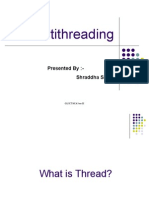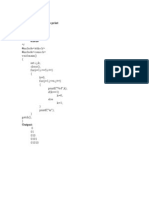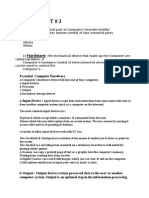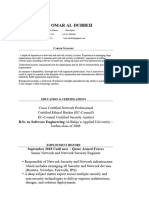Computer Network Assignment Help
Uploaded by
Computer Network Assignment HelpComputer Network Assignment Help
Uploaded by
Computer Network Assignment HelpFor any Assignment related queries, Call us at : -
+1 678 648 4277
You can mail us at : - support@computernetworkassignmenthelp.com or
reach us at : - www.computernetworkassignmenthelp.com/
Computer Network Assignment Help
Problem 2.1
Let the directed graph G be a ring: node i is connected to i + 1 if i < m and m is connected
to 1. Compute both eigenvalue centrality and Katz centrality (with = 1). Comment on your
result. Do the same for a k-regular undirected network (i.e., an undirected network in
which every vertex has degree k). You may find the steps outlined in Newman Problem 7.1
helpful. Comment on your result.
Solution:
(a) Eigenvector Centrality: For an adjacency matrix A, the eigenvector with the highest
eigenvalue represents the eigenvector centrality of each node in A. G is an orthogo-nal
matrix with the highest eigenvalue 1 and corresponding eigenvector
Here we prove that G can not have an
Computer Network Assignment Help
Here we show that 1 is an eigenvalue of A because its an orthogonal matrix with unit
vectors
This means that all eigenvalues of G 1. But since G is orthogonal, all of its eigenvalues
lie on the complex plane wit odulus 1 which means
Naturally, all nodes have equal centrality (both eigenvector and katz) due to symmetry.
Computer Network Assignment Help
Setting x1 = ... = xn = x and c = 1 and as the attenuating factor, we can write
Thus, the centralities increase as k increases. All nodes have equal centrality (both
eigenvector and katz) due to symmetry.
Problem 2.2
[Problem 7.2 from Newman] Suppose a directed network takes the form of a tree with all
edges pointing inward towards a central vertex: (see figure in Newman). What is the
PageRank centrality of the central vertex in terms of the single parameter ↵ appearing in
the definition of PageRank and the geodesic distances di from each vertex i to the central
vertex?
Computer Network Assignment Help
Solution:
We want to computer the Pagerank centrality of xc of the central vertex and we assume
that C = 1. Notice that 3 nodes have distance 3 from c, 4 nodes have distance 2 from c
and 2 nodes have distance 1 from c. Generalizing from the pattern any node that is
distance d from c will have its centrality scaled with ↵ d number of times, towards the
computation of xc.
Therefore,
Computer Network Assignment Help
Problem 2.3
(a) Give an example of such a graph with 5 nodes.
(b) Compute the eigenvalue centrality. Explain your answer.
(c) Compute the Katz centrality with = 1. Explain your answer.
Solution:
(a) Any directed acyclic graph would do. Here is an example given below
Computer Network Assignment Help
(b) Since A is nilpotent, the characteristic polynomial is t n = 0 and all the eigenvalues i are
zero. So it does not make sense to look at the eigenvector centrality, defined as the
eigenvector associated with the largest eigenvalue, max.
(c) The katz centrality is computed iteratively using
. Picking ↵ = 0.3, for instance, and = 1 we get (after 4 iterations)
Computer Network Assignment Help
ckatz = [1 1.3 1.39 1.417 1.4251]
which provides a sensible ranking if we take incoming edges to indicate importance.
Problem 2.4
As flu season is upon us, we wish to have a Markov chain that models the spread of a flu
virus. Assume a population of n individuals. At the beginning of each day, each individual is
either infected or susceptible (capable of contracting the flu). Suppose that each pair (i, j), i
6= j, independently comes into contact with one another during the daytime with probability
p. Whenever an infected individual comes into contact with a susceptible individual, he/she
infects him/her. In addition, assume that overnight, any individual who has been infected for
at least 24 hours will recover with probability 0 <q< 1 and return to being susceptible,
independently of everything else (i.e., assume that a newly infected individual will spend at
least one restless night battling the flu)
(a) Suppose that there are m infected individuals at daybreak. What is the distribution
of the number of new infections by day end?
(b) Draw a Markov chain with as few states as possible to model the spread of the flu for
n = 2. In epidemiology, this is called an SIS (SusceptibleInfected-Susceptible) model.
(c) Identify all recurrent states.
Due to the nature of the flu virus, individuals almost always develop immunity after
contracting the virus. Consequently, we improve our model and assume that individuals
become infected at most one time. Thus, we consider individuals as either infected,
susceptible, or recovered.
(d) Draw a Markov chain to model the spread of the flu for n = 2. In epidemiology, this is
called an SIR (Susceptible-Infected-Recovered) model.
(e) Identify all recurrent states.
Solution:
Computer Network Assignment Help
(a) If m out of n individuals are infected, then there must be n m susceptible individuals. Each one
of these individuals will be independently infected over the course of the day with probability p =
1 - (1 - p )m.
Thus the number of new infections, I, will be a binomial random variable with parameters n m
and p. That is,
(b) Let the state of the SIS model be the number of infected individuals. For n = 2, the
corresponding Markov chain is illustrated below.
Computer Network Assignment Help
(c) The only recurrent state is the one with 0 infected individuals
(d) Let the state of the SIR model be (S,I), where S is the number of susceptible
individuals and I is the number of infected individuals. For n = 2, the corresponding
Markov chain is illustrated below
Computer Network Assignment Help
If one did not wish to keep track of the breakdown of susceptible and recovered
individuals when no one was infected, the three states free of infections could be
consolidated into a single state as illustrated below
(e) Any state where the number of infected individuals equals 0 is a recurrent state.
For n = 2,there are either one or three recurrent states, depending on the Markov
chain drawn in part(d).
Computer Network Assignment Help
Problem 2.5
There are n fish in a lake, some of which are green and the rest blue. Each day, Helen
catches 1 fish. She is equally likely to catch any one of the n fish in the lake. She throws back
all the fish, but paints each green fish blue before throwing it back in. Let Gi denote the
event that there are i green fish left in the lake.
(a) Show how to model this fishing exercise as a Markov chain, where Gi are the
states. Explain why your model satisfies the Markov property.
(b) Find the transition probabilities pij
(c) List the transient and recurrent states
Solution:
(a) The number of remaining green fish at time n completely determines all the relevant
information of the systems entire history (relevant to predicting the future state). Therefore
it is immediate that the number of green fish is the state of the system and the process has
the Markov property:
(b) For j > i clearly pij = 0, since a blue fish will never be painted green. For 0 i, j k, we
have the following
(c) The state 0 is an absorbing state since there is a positive probability that the system
will enter it, and once it does, it will remain there forever. Therefore the state with 0
green fish is the only recurrent state, and all other states are then transient.
Computer Network Assignment Help
You might also like
- Python Data Types Data Type Python Abbreviation Explanation ExampleNo ratings yetPython Data Types Data Type Python Abbreviation Explanation Example8 pages
- Write A Program That Asks User An Arithmetic OperatorNo ratings yetWrite A Program That Asks User An Arithmetic Operator4 pages
- Write A Program To Count The Number of WordsNo ratings yetWrite A Program To Count The Number of Words5 pages
- Write A Program To Check Whether A Given String Is Palindrome or NotNo ratings yetWrite A Program To Check Whether A Given String Is Palindrome or Not14 pages
- Programming Fundamental (Swe-102) Assignment#01: Dated:28-01-2018No ratings yetProgramming Fundamental (Swe-102) Assignment#01: Dated:28-01-20186 pages
- Write A Program in C To Simulate or To Implement A Stack Using A Pointer or StructureNo ratings yetWrite A Program in C To Simulate or To Implement A Stack Using A Pointer or Structure9 pages
- Write A Program in C To Draw Line ClippingNo ratings yetWrite A Program in C To Draw Line Clipping4 pages
- Question Bank-Dot Net Framework For Application DevelopmentNo ratings yetQuestion Bank-Dot Net Framework For Application Development3 pages
- Computer Terminology - Types of ComputersNo ratings yetComputer Terminology - Types of Computers25 pages
- Data Structure Prac. No. 5 Write A Program To Insert, Delete, Display The Elements of A Queue50% (2)Data Structure Prac. No. 5 Write A Program To Insert, Delete, Display The Elements of A Queue3 pages
- Product Portfolio-Aac Blocks ManufactringNo ratings yetProduct Portfolio-Aac Blocks Manufactring15 pages
- The Thirsty Crow Story - Moral of The Short Story Thirsty CrowNo ratings yetThe Thirsty Crow Story - Moral of The Short Story Thirsty Crow2 pages
- Markov Process and Markov Chain - Solved ExamplesNo ratings yetMarkov Process and Markov Chain - Solved Examples13 pages
- What Is Computer Programming? Basics To Learn CodingNo ratings yetWhat Is Computer Programming? Basics To Learn Coding5 pages
- 菲 律 宾 郊 亚 鄢 南 星 學 校 Dalupang St., Cauayan City, Isabela, Philippines 3305 Telefax No. (078) 652-2040 School ID: 400424No ratings yet菲 律 宾 郊 亚 鄢 南 星 學 校 Dalupang St., Cauayan City, Isabela, Philippines 3305 Telefax No. (078) 652-2040 School ID: 4004244 pages
- Types of Computers: - Monalee Rodrigues ST John Institute of Management and ResearchNo ratings yetTypes of Computers: - Monalee Rodrigues ST John Institute of Management and Research8 pages
- Hotstar Clone Using HTML CSS and Bootstrap NotesNo ratings yetHotstar Clone Using HTML CSS and Bootstrap Notes73 pages
- Unit-3 Software: Need of Computer SoftwareNo ratings yetUnit-3 Software: Need of Computer Software10 pages
- Computer Network Assignment Help: Problems and Solutions0% (1)Computer Network Assignment Help: Problems and Solutions28 pages
- Network Design Assignment Help - Computer Network Assignment HelpNo ratings yetNetwork Design Assignment Help - Computer Network Assignment Help4 pages
- Advanced Computer Network Assignment HelpNo ratings yetAdvanced Computer Network Assignment Help5 pages
- Proficient Computer Network Assignment Help100% (1)Proficient Computer Network Assignment Help15 pages
- 2018 Wiring Diagram Manual - 20kw - 123127No ratings yet2018 Wiring Diagram Manual - 20kw - 1231277 pages
- Runner8 - Manual Tecnico Resumen Ingles PDFNo ratings yetRunner8 - Manual Tecnico Resumen Ingles PDF9 pages
- Virtual Fitness Trainer Using Artificial IntelligenceNo ratings yetVirtual Fitness Trainer Using Artificial Intelligence11 pages
- Detection Classification of Electrical Power System Faults Using Artificial Neural Networks IJERTV11IS090102No ratings yetDetection Classification of Electrical Power System Faults Using Artificial Neural Networks IJERTV11IS0901026 pages
- Inspection Method for Batch PCBA ProjectsNo ratings yetInspection Method for Batch PCBA Projects3 pages
- OHPRS3226 Hands-On Exercise Guide To STP RSTP MSTP ISSUE 2.00No ratings yetOHPRS3226 Hands-On Exercise Guide To STP RSTP MSTP ISSUE 2.0023 pages
- Problem Set 1 James Ryan G Lapera ID NO. 201680971 BirthdayNo ratings yetProblem Set 1 James Ryan G Lapera ID NO. 201680971 Birthday4 pages
- Digital Conversational Assets and AcceleratorsNo ratings yetDigital Conversational Assets and Accelerators23 pages
- 79545_E_20250108 - Information structure S039No ratings yet79545_E_20250108 - Information structure S0392 pages
- Make $250+ Per Week No Investment Noob Friendly Payment Proof Included0% (1)Make $250+ Per Week No Investment Noob Friendly Payment Proof Included3 pages
- Facebook English Presentation Final - AnonymNo ratings yetFacebook English Presentation Final - Anonym27 pages
- Unit 2 - Analysis and Design of Algorithms - WWW - Rgpvnotes.in PDFNo ratings yetUnit 2 - Analysis and Design of Algorithms - WWW - Rgpvnotes.in PDF15 pages
- Introduction To Mechatronics and Mechatronics in Real Life: Dr. Ir.. M. Sabri, MT. IPM. ASEAN Eng0% (1)Introduction To Mechatronics and Mechatronics in Real Life: Dr. Ir.. M. Sabri, MT. IPM. ASEAN Eng43 pages
- Instant Access to Reinventing Fashion Retailing 1st Edition Eirini Bazaki ebook Full Chapters100% (1)Instant Access to Reinventing Fashion Retailing 1st Edition Eirini Bazaki ebook Full Chapters41 pages




































































































